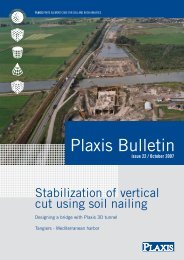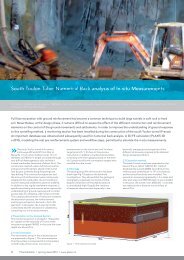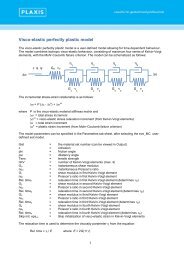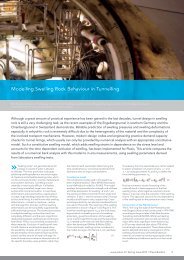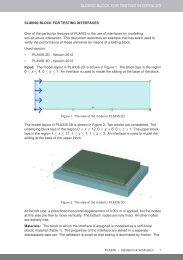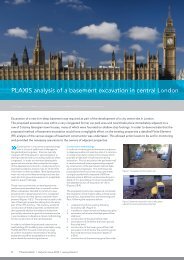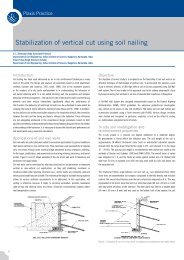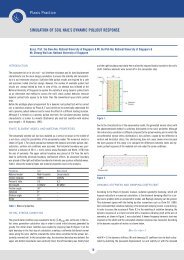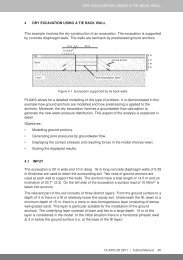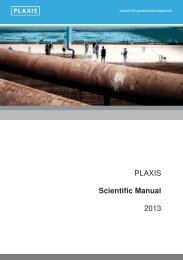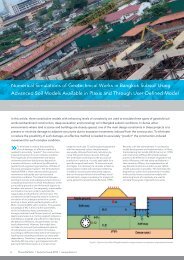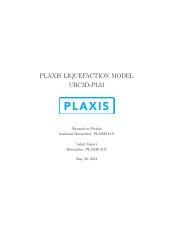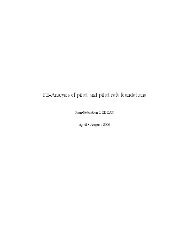Modeling passive earth pressures on bridge abutments for ... - Plaxis
Modeling passive earth pressures on bridge abutments for ... - Plaxis
Modeling passive earth pressures on bridge abutments for ... - Plaxis
You also want an ePaper? Increase the reach of your titles
YUMPU automatically turns print PDFs into web optimized ePapers that Google loves.
<strong>Plaxis</strong> PracticeHeaved Roadwayand Backfill due toPassive WedgeFigure 2. Seat-type abutment and foundati<strong>on</strong> systemn<strong>on</strong>skewed two-span single-column highway overcrossing <strong>bridge</strong>. Figure 2 shows atypical seat type <strong>bridge</strong> abutment, indicating how the <strong>bridge</strong> may move in the l<strong>on</strong>gitudinaldirecti<strong>on</strong> and collide with the abutment backwall during a seismic event. The back wall isdesigned to shear off and allows the mobilized <str<strong>on</strong>g>passive</str<strong>on</strong>g> soil pressure to be developed as aresult of backwall horiz<strong>on</strong>tal displacement.Figure 3. Passive wedges caused by an <str<strong>on</strong>g>earth</str<strong>on</strong>g>quake, Shiwei BridgeThe effect of an actual <str<strong>on</strong>g>earth</str<strong>on</strong>g>quake is shown in Figure 3. This is an example of the<str<strong>on</strong>g>passive</str<strong>on</strong>g> wedge <strong>for</strong>med when a <strong>bridge</strong> superstructure is pushed into the abutment-backfilldue to l<strong>on</strong>gitudinal seismic excitati<strong>on</strong>. The surface cracks were developed in the roadwaypavement behind the northern (23.5-m wide, near-normal 5 o skew) abutment of theShiwei Bridge in Taiwan during the Chi-Chi <str<strong>on</strong>g>earth</str<strong>on</strong>g>quake (Kosa et al, 2001).A typical highway <strong>bridge</strong> is wide and has a moderate back wall height, often 1to 2 meters. The <str<strong>on</strong>g>earth</str<strong>on</strong>g> pressure problem is then a plane strain problem and 2D FEMsimulati<strong>on</strong>s may be sufficient to simulate the soil resp<strong>on</strong>se. However, <strong>for</strong> the skewed<strong>bridge</strong>s the superstructure undergoes significant rotati<strong>on</strong>s about the vertical axisduring seismic events that result in permanently lateral offset of the deck at seat-type<strong>abutments</strong>. Due to deck rotati<strong>on</strong> the obtuse corners of the deck collides with theabutment wall and the acute corners of the deck move away from the abutment backwall.As a result asymmetric soil reacti<strong>on</strong>s are developed between the acute and obtusecorner of the abutment wall (Shamsabadi et. al, 2006), there<strong>for</strong>e, 3D analysis is neededto capture the n<strong>on</strong>linear resp<strong>on</strong>se of the backfill in between the wing walls <strong>for</strong> <strong>bridge</strong>swith skewed <strong>abutments</strong>.<strong>Plaxis</strong> simulati<strong>on</strong>s of experimental dataPassive resistance behind walls has been studied in centrifuge tests (such as by Gadreand Dobry, 1998), laboratory tests (such as by Fang et al, 1994), and large-scale or fullscaletests (such as by Romstad et al., 1995 and documented by Martin et al., 1997).Recent full-scale tests at Bingham Young University (BYU) are reported by Rollins andCole (2006). Large-scale tests are currently being per<strong>for</strong>med at University of Cali<strong>for</strong>niaSan Diego and at University of Cali<strong>for</strong>nia Los Angeles to capture the n<strong>on</strong>linear <strong>for</strong>cede<strong>for</strong>mati<strong>on</strong>characteristics of the abutment-backfill <strong>for</strong> the seismic design of <strong>bridge</strong>structures.A series of full-scale static load tests was per<strong>for</strong>med by Rollins and Cole (2006) <strong>on</strong> a 5.18m by 3.05 m pile cap with a height of 1.12 m embedded in five types of soil backfills.The backfill was placed in layers and compacted to approximately 95% Modified Proctordensity. The pile cap rested <strong>on</strong> a 3 by 4 group of 324-mm diameter steel pipe piles drivenin saturated low-plasticity silts and clays. The resistance of the piles was subtractedfrom the measured total horiz<strong>on</strong>tal resistance of the pile cap to determine the mobilized<str<strong>on</strong>g>passive</str<strong>on</strong>g> resistance of the backfill. Depending <strong>on</strong> the backfill properties, the measured<str<strong>on</strong>g>earth</str<strong>on</strong>g> pressure <strong>for</strong>ce <strong>on</strong> the back wall varied from 750 kN to 2000 kN at a horiz<strong>on</strong>tal walldisplacement of about 6 cm.Figure 4 shows the schematics of a typical BYU pile cap field experiment with the threedimensi<strong>on</strong>al<str<strong>on</strong>g>passive</str<strong>on</strong>g> wedge bounded by a logarithmic-spiral type failure surface, based<strong>on</strong> field measurements of observed cracking patterns and wedge de<strong>for</strong>mati<strong>on</strong>s by Rollinsand Cole (2006).Mobilized limit-equilibrium methodsThe results of the experimental n<strong>on</strong>linear <strong>for</strong>ce-de<strong>for</strong>mati<strong>on</strong> resp<strong>on</strong>se from a number offull-scale tests, centrifuge model tests and small-scale laboratory tests <strong>for</strong> walls, <strong>bridge</strong><strong>abutments</strong> and pile caps in a variety of structure backfills have been studied using amodel by Shamsabadi et al. (2006). This two-dimensi<strong>on</strong>al plane-strain model is based<strong>on</strong> limit-equilibrium using a Logarithmic-Spiral failure surface coupled with a modifiedHyperbolic stress-strain relati<strong>on</strong>ship (“LSH”). Good agreement was found between the“LSH” model and the experimental data. The computed results from the “LSH” modelwere multiplied by an adjustment factor a varying between 1.2 and 1.4 to account <strong>for</strong> thethree-dimensi<strong>on</strong>al shape of the mobilized <str<strong>on</strong>g>passive</str<strong>on</strong>g> wedge in the backfill (see Figure 4).The <strong>for</strong>ce-de<strong>for</strong>mati<strong>on</strong> relati<strong>on</strong>ships calculated using 3D <strong>Plaxis</strong> were compared againstexperimental data without any adjustment factor.
<strong>Plaxis</strong> Practicewhere P pis 50% of the ultimate <str<strong>on</strong>g>passive</str<strong>on</strong>g> <str<strong>on</strong>g>earth</str<strong>on</strong>g> pressure <strong>for</strong>ce acting over a total back wallarea of A = W·H, and σ h’ = P p/A. The fracti<strong>on</strong> 50% is chosen to give a “half way tofailure” average stiffness. The wall width W is 5,180 mm in the BYU test (Figure 4).Turning equati<strong>on</strong> 2 around we obtain:E = 2k 50= 2.100kN / mm = 40MPa (3)W 5180mmWe note that 40MPa is a stiffness c<strong>on</strong>siderably lower than the input values used, butthe average stiffness of 40MPa is not a reference stiffness. Applying rough, averagerefparameters (a=5 kPa, p’ ref=100 kPa, σ 3=15 kPa), the input stiffness parameter E 50canbe estimated to:p’refE 50= E ref+ a50= 40MPa 100kPa + 5kPa = 90MPa (4)σ h+ a15kPa + 5kPaPlease keep in mind that this is a crude estimate. It may still indicate why we apply theinput reference stiffness (100 MPa ) <strong>for</strong> the high-quality gravel and sand backfill.The parameters used in the Hardening Soil model are identical to the parameters used inthe “LSH” model proposed by Shamsabadi et al (2006). Following the recommendati<strong>on</strong>by Shamsabadi et al. (2006), the Hyperbola cut off parameter, Rf, was set equal to 0.97.This gives a better match with the measured n<strong>on</strong>linear <strong>for</strong>ce-de<strong>for</strong>mati<strong>on</strong> than the defaultvalue of 0.90 proposed in the <strong>Plaxis</strong> user manual. A pre-c<strong>on</strong>solidati<strong>on</strong> effect due to compacti<strong>on</strong>of the backfill was originally used, but resulted in a rather sharp drop in stiffnessas the applied load was increased bey<strong>on</strong>d the pre-c<strong>on</strong>solidati<strong>on</strong> pressure. Such a drop isnot observed in the experimental data. There<strong>for</strong>e, the OCR was set equal to <strong>on</strong>e and theeffect of the backfill compacti<strong>on</strong> was taken into account using the stiffness parameterslisted in table 1.Computed resultsBoth the 3D Tunnel and the 3D Foundati<strong>on</strong> programs were used in this study. The simulati<strong>on</strong>swere d<strong>on</strong>e using a half-wall-width model due to symmetry of the problem. Figure 6shows the half-model of the geometry used with a medium coarse mesh as applied in the 3DFoundati<strong>on</strong> program. The use of a finer mesh did not change the results significantly, butmade c<strong>on</strong>vergence at large de<strong>for</strong>mati<strong>on</strong>s c<strong>on</strong>siderably more difficult.Sequence of the eventsAll the analysis was per<strong>for</strong>med in steps to simulate sequence of the real events during thefield experiments. The computati<strong>on</strong>s were simulated using the following steps:1- Starting with a level ground the initial stresses were calculated.2- Excavati<strong>on</strong> was per<strong>for</strong>med by deactivating clusters of elements in the fr<strong>on</strong>t of the pilecap.3- In 3D Tunnel, displacements were applied while in 3D Foundati<strong>on</strong>s distributed normalstresses were applied to push the pile cap up to backfill failure.Be<strong>for</strong>e the field experiment, the backfill was placed and compacted behind the wall.The backfill was extended to the sides behind the pilecap, but no backfill was placedal<strong>on</strong>g the sides of the pile cap. This is why the simulati<strong>on</strong>s were per<strong>for</strong>med as shown inFigure 5. The “free” vertical soil face in the model is supported by a K opressure andincreased linearly below ground surface. This pressure is kept c<strong>on</strong>stant throughout thetest. The wall was pushed then horiz<strong>on</strong>tally without any vertical movement. In <strong>Plaxis</strong> 3DFoundati<strong>on</strong>s, horiz<strong>on</strong>tal translati<strong>on</strong> was obtained by adding an extended “handle” normalto the wall plate (see Figure 5) and specifying the appropriate horiz<strong>on</strong>tal line fixity <strong>on</strong> the“handle’s” lower edge.The simulated load de<strong>for</strong>mati<strong>on</strong> curves are shown in Figure 6 to Figure 9. Figure 6 showsthe sandy gravel experiment, giving an ultimate load <strong>for</strong> the 5.18 x 1.12 m 2 wall of about1000 kN. The initial stiffness is in the order of 1500 kN/cm which corresp<strong>on</strong>ds to about250 kPa/cm. Figure 7 shows results <strong>for</strong> Coarse Grained Gravel and Figure 8 shows results<strong>for</strong> Fine Grained Gravel where the ultimate capacity is about 2000 kN and 780 KN, respectively.The initial stiffness is however about the same as <strong>for</strong> Sandy Gravel. Figure 9 showsthe result of the simulati<strong>on</strong> <strong>for</strong> the silty sand backfill. There is a good agreement betweenthe <strong>Plaxis</strong> simulati<strong>on</strong>s and the experimental curves.Figure 5. A half model of the BYU field test, medium coarse mesh, 3D Foundati<strong>on</strong>sSome of the load-de<strong>for</strong>mati<strong>on</strong> curves simulated by both <strong>Plaxis</strong> 3D Foundati<strong>on</strong> andTunnel are not smooth and show some minor irregularities. Some of this is related to thedevelopment of alternative plastic failure mechanisms as illustrated by Figure 10 andFigure 11. Figure 10 shows two failure “competing” mechanisms. Figure 11 shows that<strong>on</strong>e mechanism becomes more dominant as de<strong>for</strong>mati<strong>on</strong> increases. Figure 7 shows thechange in the inclinati<strong>on</strong> of the simulated n<strong>on</strong>linear load-de<strong>for</strong>mati<strong>on</strong> curve at about3 cm. This is a reflecti<strong>on</strong> of the fluctuating failure mechanism. Such behavior was seenin several simulati<strong>on</strong>s and is believed to be attributed to the inherent minor instabilityof n<strong>on</strong>-associative plasticity. The authors believe that such feature may also be seen inreal soil behavior.11
<strong>Plaxis</strong> Practice<str<strong>on</strong>g>Modeling</str<strong>on</strong>g> <str<strong>on</strong>g>passive</str<strong>on</strong>g> <str<strong>on</strong>g>earth</str<strong>on</strong>g> <str<strong>on</strong>g>pressures</str<strong>on</strong>g> <strong>on</strong> <strong>bridge</strong><strong>abutments</strong> <strong>for</strong> n<strong>on</strong>linear Seismic Soil -Structure interacti<strong>on</strong> using <strong>Plaxis</strong>C<strong>on</strong>tinuati<strong>on</strong>Figure 12 show examples of the logarithmic spiral failure surface mechanism usingthe <strong>Plaxis</strong> 3D Tunnel. There is a good match between simulated de<strong>for</strong>med shapes of the<str<strong>on</strong>g>passive</str<strong>on</strong>g> wedges from the 3D <strong>Plaxis</strong> and the BYU pile cap experiments mapped in thefield.Test data3D Tunnel3D FoundTest data3D Tunnel3D FoundFigure 8. Load deflecti<strong>on</strong> curves <strong>for</strong> Fine Grained GravelFigure 6. Load deflecti<strong>on</strong> curves <strong>for</strong> Clean SandTest data3D Tunnel3D FoundTest data3D Tunnel3D FoundFigure 9. Load deflecti<strong>on</strong> curves <strong>for</strong> Silty SandFigure 7. Load deflecti<strong>on</strong> curves <strong>for</strong> Coarse Grained GravelFigure 10. Coarse Grained Gravel, incremental shear strain c<strong>on</strong>tours at 3 cmde<strong>for</strong>mati<strong>on</strong>12
<strong>Plaxis</strong> Practice(a) Typical de<strong>for</strong>med mesh with total displacement c<strong>on</strong>toursFigure 11. Coarse Grained Gravel, incremental shear strain c<strong>on</strong>tours at 6 cm de<strong>for</strong>mati<strong>on</strong>Simulati<strong>on</strong> timeThe computer simulati<strong>on</strong>s were fast using the <strong>Plaxis</strong> default coarse mesh. The coarsemesh was found to be too rough and mesh refinement with several mesh densities havebeen tried. The time required <strong>for</strong> each computer simulati<strong>on</strong> depends primarily <strong>on</strong> the meshdensity but also <strong>on</strong> the selecti<strong>on</strong> of parameters <strong>for</strong> the iterative procedure to obtain properc<strong>on</strong>vergence. C<strong>on</strong>vergence was more slow <strong>for</strong> certain combinati<strong>on</strong>s of stiffness, fricti<strong>on</strong>,cohesi<strong>on</strong> and dilatancy parameters. Still coarse meshes were analyzed in a few minuteswhile the <strong>on</strong>es shown above take from half an hour to more than an hour <strong>on</strong> a Pers<strong>on</strong>alComputer. It is c<strong>on</strong>firmed that simulating an indentati<strong>on</strong> problem to large de<strong>for</strong>mati<strong>on</strong>sare numerically challenging and hence manual iterati<strong>on</strong> c<strong>on</strong>trol was used. The overrelaxati<strong>on</strong>factor was often set to 1.0 while low values were selected <strong>for</strong> the desirednumber of iterati<strong>on</strong>s. Some of the results are obtained by using a tolerated error of 3%.It was observed that using high tolerated errors even up to 10% did not change thecomputed results significantly compared to a 1% tolerated error analysis. A proposedexplanati<strong>on</strong> <strong>for</strong> this may be that divergence tendencies, when they occur, appears to berelated to z<strong>on</strong>es with tensi<strong>on</strong> and stress c<strong>on</strong>centrati<strong>on</strong>s in corners, not so much to thevolume of soil mainly providing the <str<strong>on</strong>g>passive</str<strong>on</strong>g> resistance. Still, high tolerated errors shouldnever be used uncritically.Mesh size3D simulati<strong>on</strong>s accentuate mesh dependency since normally a rather low number ofelements is used to avoid excessive computati<strong>on</strong> times. At the same time 3Dsimulati<strong>on</strong>s require lower order elements. In order to get a feeling <strong>for</strong> the effect ofmesh refinement and compare 2D simulati<strong>on</strong>s to 3D simulati<strong>on</strong>s, a true 2D problemwas analyzed using both <strong>Plaxis</strong> 2D and <strong>Plaxis</strong> 3D Foundati<strong>on</strong>s, Figure 13 and Figure 14.Three different mesh densities were used in 3D with a Mohr Coulomb soil withγ = 22 KN/m 3 , E = 30 MPa, ν = 0.3, c = 20 kPa, ϕ = 38,7 0 and ψ = 10 0 .Drained c<strong>on</strong>diti<strong>on</strong>s and no groundwater are assumed. The same soil parameters and avery fine mesh were used <strong>for</strong> <strong>Plaxis</strong> 2D.(b) Typical shaded plot of total displacement c<strong>on</strong>tours(c) Cross secti<strong>on</strong> of incremental shear strain(d) Cross secti<strong>on</strong> of plastic points in the incremental shear strain z<strong>on</strong>eFigure 12. Results from a half wall width simulati<strong>on</strong> with 3D Tunnel.13
<strong>Plaxis</strong> Practice<str<strong>on</strong>g>Modeling</str<strong>on</strong>g> <str<strong>on</strong>g>passive</str<strong>on</strong>g> <str<strong>on</strong>g>earth</str<strong>on</strong>g> <str<strong>on</strong>g>pressures</str<strong>on</strong>g> <strong>on</strong> <strong>bridge</strong><strong>abutments</strong> <strong>for</strong> n<strong>on</strong>linear Seismic Soil -Structure interacti<strong>on</strong> using <strong>Plaxis</strong>C<strong>on</strong>tinuati<strong>on</strong>All the load deflecti<strong>on</strong> curves given in Figure 14 are identical up until about 50% ofthe capacity where after they deviate. The deviati<strong>on</strong> is c<strong>on</strong>siderable <strong>for</strong> the coarse 3Dmesh. This might be expected since it is very coarse with <strong>on</strong>ly two elements over the wallheight. Some uncertainty is related to the irregularity of the curves. The medium 3D meshappears to per<strong>for</strong>m satisfactorily, and the overshoot <strong>for</strong> rather crude meshes is less than20%. Some overshoot can be expected unless very fine meshes are used. If the expectedpercentage of overshoot is roughly known, a reas<strong>on</strong>ably good simulati<strong>on</strong> can be achievedusing a medium dense mesh. For geotechnical applicati<strong>on</strong>s, a medium dense meshappears to be an decent trade-off between accuracy and computing time.C<strong>on</strong>clusi<strong>on</strong>sA full 3D <strong>Plaxis</strong> stiffness degradati<strong>on</strong> model <strong>for</strong> the <strong>bridge</strong> abutment-backfill has beenpresented. The model simulates stiffness degradati<strong>on</strong> behavior of the abutment-backfillto replicate the stiffness the degradati<strong>on</strong> which has been observed during a majorseismic event. The authors found that there is a very good agreement between then<strong>on</strong>linear experimental <strong>for</strong>ce-de<strong>for</strong>mati<strong>on</strong> behavior of the mobilized <str<strong>on</strong>g>passive</str<strong>on</strong>g> wedge andthe 3D <strong>Plaxis</strong> simulati<strong>on</strong>s using the Hardening Soil Model.For simulati<strong>on</strong> of wide <strong>bridge</strong> <strong>abutments</strong> where plane-strain c<strong>on</strong>diti<strong>on</strong>s can beassumed, it is the authors recommendati<strong>on</strong> that the <strong>Plaxis</strong> 2D should be used without anyadjustment factors <strong>for</strong> the 3D effects. In other cases such as skewed abutment dueto <strong>bridge</strong> rotati<strong>on</strong>, a 3D simulati<strong>on</strong> is more relevant. Based <strong>on</strong> the full-scaled experimentsof the more narrow <strong>abutments</strong> studied in this article, the 3D effect can result inincrease of 20 to 40% in <str<strong>on</strong>g>passive</str<strong>on</strong>g> soil resistance compared to a plane-strain case. Theanalyses indicate that 3D simulati<strong>on</strong>s give realistic results. A medium mesh size is foundto give reas<strong>on</strong>able results <strong>for</strong> geotechnical applicati<strong>on</strong>s. The <strong>Plaxis</strong> results are in goodagreement with the experimental results and the simulati<strong>on</strong>s provide valuable in<strong>for</strong>mati<strong>on</strong><strong>on</strong> the soil parameters and the failure mechanism. <strong>Plaxis</strong> can be a valuable analysis tool<strong>for</strong> the researchers and practicing <strong>bridge</strong> engineers to evaluate realistic n<strong>on</strong>linear soilabutment-structureinteracti<strong>on</strong> behavior.(a) Coarse mesh(b) Medium mesh{c) Fine meshFigure 13. Effect of mesh sensitivity using <strong>Plaxis</strong> 3D Foundati<strong>on</strong>sFigure 14. Load deflecti<strong>on</strong> curves illustrating mesh dependency14
<strong>Plaxis</strong> PracticeReferences:PLAXIS 2DPLAXIS 3D TunnelPLAXIS 3D Foundati<strong>on</strong>sFang, Y.-S., Chen, T.-J., and Wu, B.-F. (1994). Passive Earth Pressures with Various WallMovements. Journal of Geotechnical Engineering, ASCE, Vol. 120, No. 8, pp. 1307-1323.Gadre, A. D., and Dobry, R. (1998). Centrifuge <str<strong>on</strong>g>Modeling</str<strong>on</strong>g> of Cyclic Lateral Resp<strong>on</strong>se of Pile-Cap Systems and Seat-Type Abutments in Dry Sand. Report MCEER-98-0010, RensaelerInstitute, Civil Engineering Dept., Troy, NY.Gadre, A.D. (1997), Lateral Resp<strong>on</strong>se of Pilecap Foundati<strong>on</strong> System and Seat-typeAbutment in Dry Sand, PhD Dissertati<strong>on</strong>, RPI.Martin, G. R., Yan, L.-P., and Lam, I. P. (1997). Development and Implementati<strong>on</strong> ofImproved Seismic Design and Retrofit Procedures <strong>for</strong> Bridge Abutments, Final Report,Research Project Funded by the Cali<strong>for</strong>nia Department of Transportati<strong>on</strong>, September.Romstad, K., Kutter, B., Mar<strong>on</strong>ey, B., Vanderbilt, E., Griggs, M., and Chai, Y. H. (1995).Experimental Measurements of Bridge Abutment Behavior. Department of Civil andEnvir<strong>on</strong>mental Engineering, University of Cali<strong>for</strong>nia, Davis, Report No. UCD-STR-95-1,September.Rollins, K.M., and Cole, R.T. (2006), “Cyclic Lateral Load Behavior of a Pile Cap andBackfill,” accepted <strong>for</strong> publicati<strong>on</strong>, Journal of Geotechnical and Geoenvir<strong>on</strong>mentalEngineering.Shamsabadi, A., Kapuskar, M. and A. Zand (2006), “Three-dimensi<strong>on</strong>al N<strong>on</strong>linear FiniteElement Soil-Abutment-Structure Interacti<strong>on</strong> <strong>for</strong> SkewedBridges,” Fifth Nati<strong>on</strong>al SeismicC<strong>on</strong>ference <strong>on</strong> Bridges & Highways” September 18-20, 2006 in San FranciscoShamsabadi, A., Rollins, K., and Kapuskar, M. (2006), “N<strong>on</strong>linear Soil-Abutment-BridgeStructure Interacti<strong>on</strong> <strong>for</strong> Seismic Per<strong>for</strong>mance-Based Design,” Journal of Geotechnicaland Geoenvir<strong>on</strong>mental Engineering, ASCE (under review <strong>for</strong> publicati<strong>on</strong>).Shamsabadi, A., and Kapuskar, M. (2006), “Practical N<strong>on</strong>linear Abutment Model <strong>for</strong>Seismic Soil-Structure Interacti<strong>on</strong> Analysis,” 4th Int’l Workshop <strong>on</strong> Seismic Design andRetrofit of Transportati<strong>on</strong> Facilities, San Francisco, March 13-14.15



